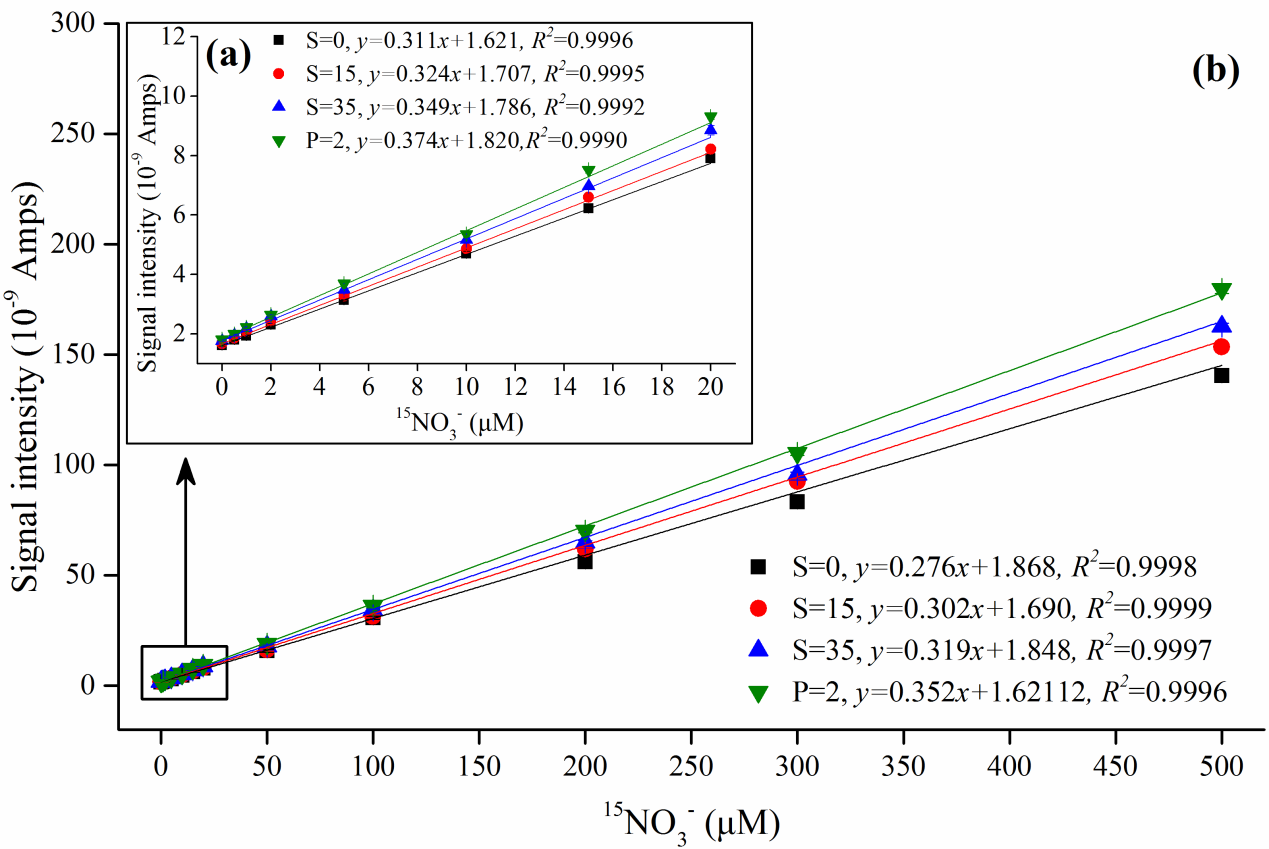Using 15N stable isotope as a tracer to quantify N transformation rates in isotope-enrichment experiments improves understanding of the N cycle in various ecosystems. However, measuring 15N-nitrate (15NO3–) in small volumes of water for these experiments is a major challenge due to the inconvenience of preparing samples by traditional techniques. Lin et al. (2021) developed a “REOX/MIMS” method by applying membrane inlet mass spectrometry (MIMS, Hiden HPR-40, Hiden Analytical Ltd., Warrington, UK) to determining 15NO3– concentrations in a small volume of water from isotope-enrichment experiments after converting the dissolved inorganic N to N2. The nitrates (NO3– + NO2–) were reduced to NH4+ with zinc powder, and the ammonium (NH4+) was then oxidized to N2 by hypobromite iodine solution. The resulting 29N2 and 30N2 were measured via MIMS. This optimized protocol provides a sensitive (~0.1 μM) and precise (relative standard deviation = 0.1–4.37%) approach to quantify 15NO3– concentrations (0.1–500 µM) in water samples over a wide range of salinities (0–35 ‰) and in 2 M KCl solution with excellent calibration curves (R2 ≥ 0.9996, p < 0.0001). The method was combined with 15NO3– isotope-enrichment incubation experiments to measure gross nitrification and gross NO3– immobilization rates in various ecosystems. It was rapid, accurate, and cost-effective. Future applications of this efficient approach will inform scientists, modelers and decision makers about mechanisms, sources, fates, and effects of NO3– delivered to or produced in numerous aquatic and terrestrial ecosystems. The privous OX/MIMS method has be expanded successfully to determine DNRA, N fixation, mineralization and immobilization with isotope tracer or dilution techniques in sediments of aquatic environments (Yin, et al, 2014; Hou et al., 2018; Lin et al., 2016a; Lin et al., 2016b; Lin et al., 2017). Extending use of the MIMS to measurements of 15NO3– using the described REOX/MIMS method provides a convenient and cost-effective approach to determine gross nitrification, gross N mineralization and immobilization, and N fixation rates, and extends the application field of MIMS to terrestrial ecosystems. In addition, REOX/MIMS has been extended to determine DO15N concentration using UV oxidation (Lu et al., 2020). With this method, we can quantify the main N-transformation processes in the soils/sediments from various ecosystems using a MIMS.

Fig. 1. The general procedure of the “REOX/MIMS” method for determination of 15NO3– in aqueous samples (a) and the schematic diagram of self-assembled membrane injection mass spectrometry system (b); The main components of this system are: sample vial (S), injection peristaltic pump (P), constant temperature water bath (T), stainless steel capillary (SC), membrane injector (M, including a gas-permeable silicone elastomer tube and a thick glass tubing), waste recovery bottle (W), cold trap (C), copper reduction furnace (F, containing a quartz tube with reduced copper wire), vacuum system (V), Ion source (I), quadrupole mass analyzer (Q), secondary electron multiplier (SEM), data processing system (D).

Fig. 2. Relationships of the known 15NO3– concentrations with measured signal intensities of total 15N (29N2+2×30N2) under optimal condition at salinity of 0, 15, and 35 ‰, as well as at solution of 2 M KCl. Vertical bars denote the standard errors (n = 3). S and P represent salinity and 2 M KCl, respectively.

Fig. 3. (a) Relationships of the measured 15N fraction (0.5, 1, 5, 10, 25, 50, and 75%) with expected 15N fraction for standards at 500 μM, (b) 15N abundances measured by at different NO3– concentrations (n = 3, mean and standard deviation)
References
- Lin XB, Lu KJ, Hardison AK, Xu X, Gao DZ, Gong J*, Gardner WS. New membrane inlet mass spectrometry method (REOX/MIMS) to measure 15N-nitrate in isotope-enrichment experiments: Analytical technique and applications. Ecological Indicartors, 2021, 126: 107639.
- Lin XB, Hou LJ, Liu M, Li XF, Yin GY, Zheng YL, et al. Gross nitrogen mineralization in surface sediments of the Yangtze Estuary. PLoS ONE 2016a; 11: e0151930. Doi: 10.1371/journal.pone.0151930.
- Lin XB, Hou LJ, Liu M, Li XF, Zheng YL, Yin GY, et al. Nitrogen mineralization and immobilization in sediments of the East China Sea: Spatiotemporal variations and environmental implications. J. Geophys. Res. Biogeosci. 2016b; 121: 2842-2855. Doi: 10.1002/2016JG003499.
- Lin XB, Li XF, Gao DZ, Liu M, Cheng L. Ammonium production and removal in the sediments of Shanghai River networks: Spatiotemporal variations, controlling factors, andenvironmental implications. J. Geophys. Res. Biogeosci. 2017a; 122: 2461-2478. Doi: 10.1002/2017JG003769.
- Yin GY, Hou LJ, Liu M, Liu ZF, Gardner WS. A novel membrane inlet mass spectrometer method to measure 15NH4+ for isotope-enrichment experiments in aquatic ecosystems. Environ. Sci. Technol. 2014; 48: 9555-9562. Doi: 10.1021/es501261s.
- Lu KJ, Lin XB, Gardner WS, Liu ZF. A streamlined method to quantify the fates of 15N in seawater samples amended with 15N-labeled organic nitrogen. Limnology and Oceanography: Methods. 2020; 18(2): 52-62. Doi:1002/lom3.10345.
Paper Reference: “Membrane inlet mass spectrometry method (REOX/MIMS) to measure 15N-nitrate in isotope-enrichment experiments”, Ecological Indicators 2021, 126, 107639 https://doi.org/10.1016/j.ecolind.2021.107639
Hiden Product: HPR-40 DSA
Project Summary Reference: AP-HPR-40-202105
View Full Paper: Membrane inlet mass spectrometry method (REOX_MIMS) to measure 15N-nitrate in isotope-enrichment experiments
To find out more about this product visit the HPR-40 DSA product page or if you would like to contact us directly please Send us a Message.

